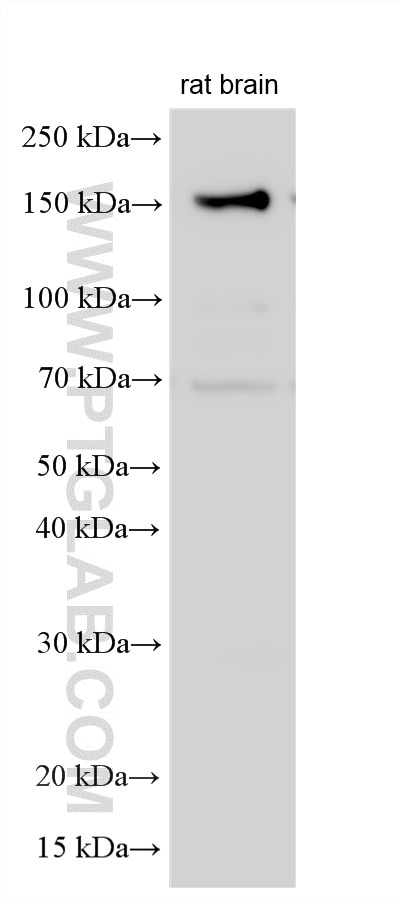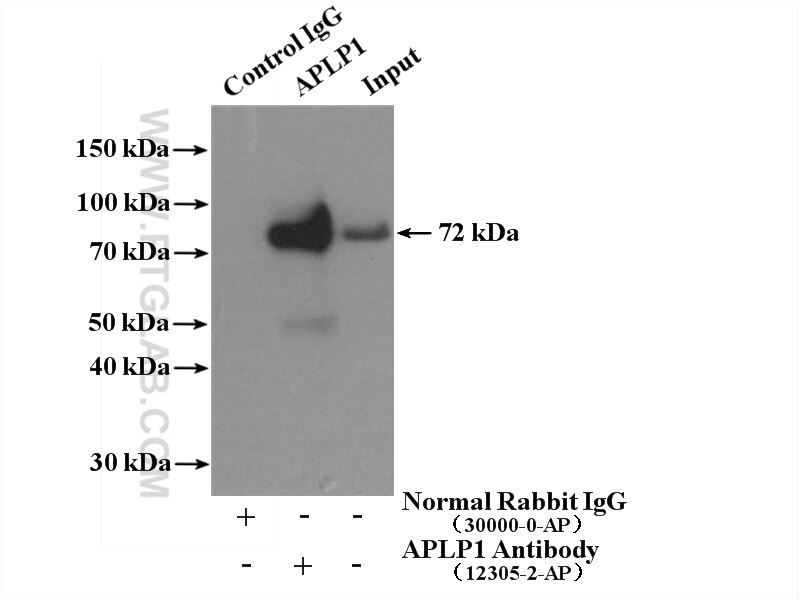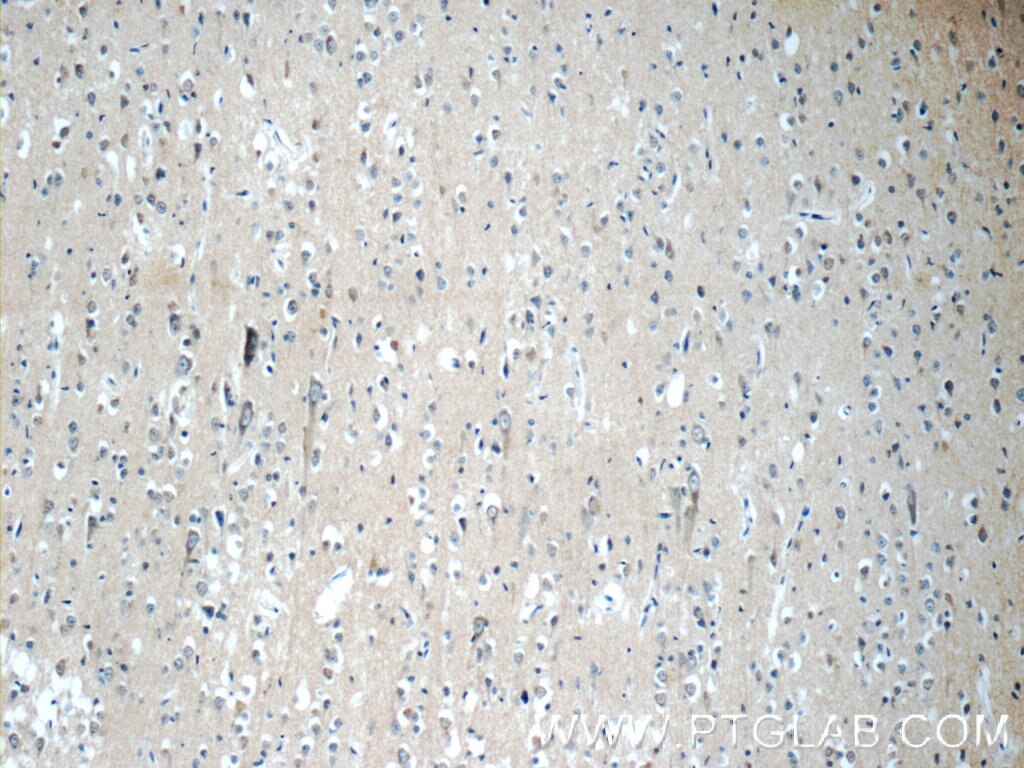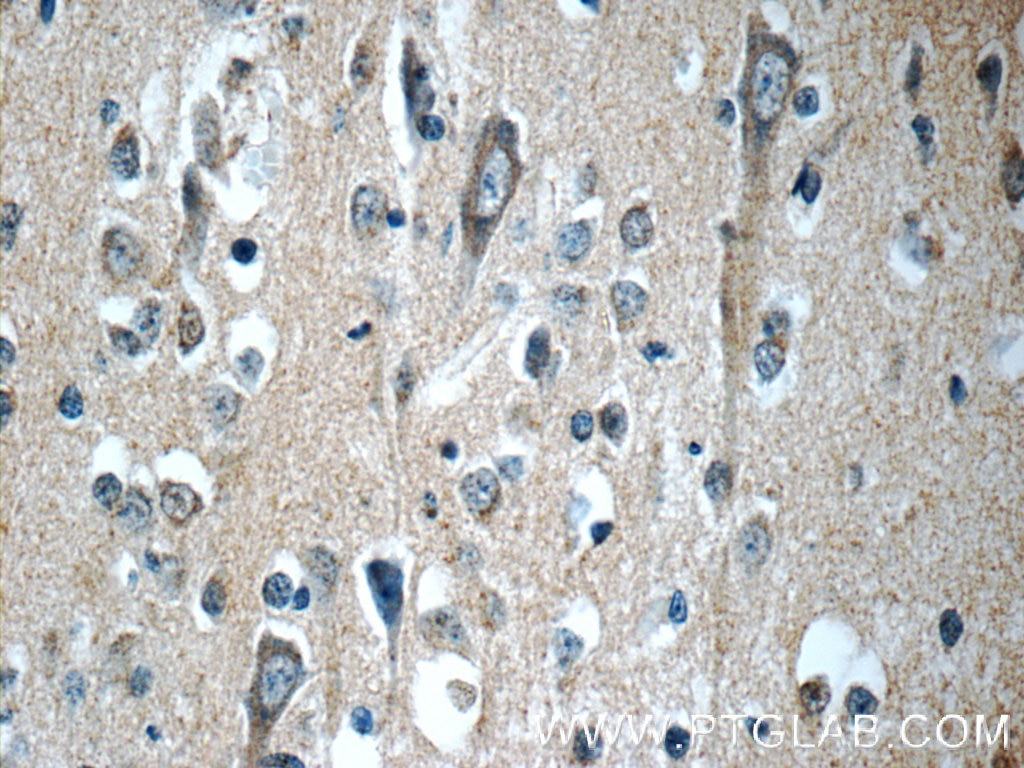Tested Applications
| Positive WB detected in | mouse brain tissue, rat brain tissue |
| Positive IP detected in | mouse brain tissue |
| Positive IHC detected in | human brain tissue Note: suggested antigen retrieval with TE buffer pH 9.0; (*) Alternatively, antigen retrieval may be performed with citrate buffer pH 6.0 |
Recommended dilution
| Application | Dilution |
|---|---|
| Western Blot (WB) | WB : 1:500-1:2000 |
| Immunoprecipitation (IP) | IP : 0.5-4.0 ug for 1.0-3.0 mg of total protein lysate |
| Immunohistochemistry (IHC) | IHC : 1:20-1:200 |
| It is recommended that this reagent should be titrated in each testing system to obtain optimal results. | |
| Sample-dependent, Check data in validation data gallery. | |
Published Applications
| WB | See 4 publications below |
Product Information
12305-2-AP targets APLP1 in WB, IHC, IP, ELISA applications and shows reactivity with human, mouse, rat samples.
| Tested Reactivity | human, mouse, rat |
| Cited Reactivity | human, mouse |
| Host / Isotype | Rabbit / IgG |
| Class | Polyclonal |
| Type | Antibody |
| Immunogen |
CatNo: Ag2951 Product name: Recombinant human APLP1 protein Source: e coli.-derived, PGEX-4T Tag: GST Domain: 55-341 aa of BC012889 Sequence: QVAGLCGRLTLHRDLRTGRWEPDPQRSRRCLRDPQRVLEYCRQMYPELQIARVEQATQAIPMERWCGGSRSGSCAHPHHQVVPFRCLPGEFVSEALLVPEGCRFLHQERMDQCESSTRRHQEAQEACSSQGLILHGSGMLLPCGSDRFRGVEYVCCPPPGTPDPSGTAVGDPSTRSWPPGSRVEGAEDEEEEESFPQPVDDYFVEPPQAEEEEETVPPPSSHTLAVVGKVTPTPRPTDGVDIYFGMPGEISEHEGFLRAKMDLEERRMRQINEVMREWAMADNQSKN Predict reactive species |
| Full Name | amyloid beta (A4) precursor-like protein 1 |
| Calculated Molecular Weight | 650 aa, 72 kDa |
| Observed Molecular Weight | 72 kDa |
| GenBank Accession Number | BC012889 |
| Gene Symbol | APLP1 |
| Gene ID (NCBI) | 333 |
| RRID | AB_2056369 |
| Conjugate | Unconjugated |
| Form | Liquid |
| Purification Method | Antigen affinity purification |
| UNIPROT ID | P51693 |
| Storage Buffer | PBS with 0.02% sodium azide and 50% glycerol, pH 7.3. |
| Storage Conditions | Store at -20°C. Stable for one year after shipment. Aliquoting is unnecessary for -20oC storage. 20ul sizes contain 0.1% BSA. |
Background Information
APLP1 (Amyloid Precursor-Like Protein 1) is a member of the amyloid precursor protein (APP) family, which also includes APP and APLP2. It is a type I transmembrane glycoprotein that is highly and predominantly expressed in the central nervous system, especially at the postsynaptic density of neurons. Functionally, APLP1 plays important roles in synaptic adhesion, synaptogenesis, and neurite outgrowth. It can form homophilic trans-interactions between neighboring cells, contributing to cell-cell adhesion and the formation of synaptic structures. Its proteolytic processing by α-, β-, and γ-secretases releases intracellular fragments that may participate in transcriptional regulation and signal transduction, potentially influencing gene expression and neuronal survival.
Protocols
| Product Specific Protocols | |
|---|---|
| IHC protocol for APLP1 antibody 12305-2-AP | Download protocol |
| IP protocol for APLP1 antibody 12305-2-AP | Download protocol |
| WB protocol for APLP1 antibody 12305-2-AP | Download protocol |
| Standard Protocols | |
|---|---|
| Click here to view our Standard Protocols |
Publications
| Species | Application | Title |
|---|---|---|
Sci Transl Med Tau and other proteins found in Alzheimer's disease spinal fluid are linked to retromer-mediated endosomal traffic in mice and humans. | ||
EMBO J Secretome protein enrichment identifies physiological BACE1 protease substrates in neurons. | ||
Mol Cell Proteomics Label-free quantitative proteomics of mouse cerebrospinal fluid detects BACE1 protease substrates in vivo. | ||
J Proteome Res Label-Free LC-MS/MS Proteomic Analysis of Cerebrospinal Fluid Identifies Protein/Pathway Alterations and Candidate Biomarkers for Amyotrophic Lateral Sclerosis. | ||
J Biol Chem Familial Alzheimer's disease mutations in amyloid precursor protein impair calcineurin signaling to NMDA receptors |












